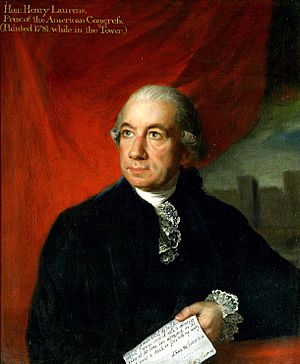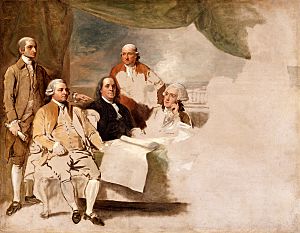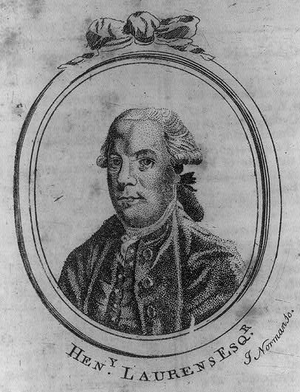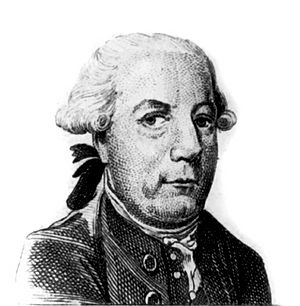Henry Laurens facts for kids
Quick facts for kids
Henry Laurens
|
|
|---|---|

Laurens depicted by Lemuel Francis Abbott, 1781 or 1784
|
|
| 5th President of the Continental Congress | |
| In office November 1, 1777 – December 9, 1778 |
|
| Preceded by | John Hancock |
| Succeeded by | John Jay |
| Vice President of South Carolina | |
| In office March 26, 1776 – June 27, 1777 |
|
| President | John Rutledge |
| Preceded by | Office Established |
| Succeeded by | James Parsons |
| President of the South Carolina Committee on Safety |
|
| In office January 9, 1775 – March 26, 1776 |
|
| Monarch | George III |
| Preceded by | William Campbell As governor of South Carolina |
| Succeeded by | John Rutledge As president of South Carolina |
| Personal details | |
| Born | March 6, 1724 Charleston, Province of South Carolina |
| Died | December 8, 1792 (aged 68) Charleston, South Carolina, U.S. |
| Spouse | Eleanor Ball (m. 1750; b. 1731 – d. 1770) |
| Children | John Laurens Martha Laurens Ramsay Henry Laurens, Jr. James Laurens Mary Eleanor Laurens Pinckney |
| Signature | |
Henry Laurens (March 6, 1724 – December 8, 1792) was an important American leader during the American Revolutionary War. He was a Founding Father, a successful merchant, and a rice planter from South Carolina.
Laurens became a key political figure during the Revolution. He was a delegate to the Second Continental Congress and later served as its president, taking over from John Hancock. He also signed the Articles of Confederation, which was the first constitution of the United States. Laurens was also the United States minister to the Netherlands during the war. He was even captured by the British and held in the Tower of London. His oldest son, John Laurens, was a close helper to George Washington and a colonel in the army.
Contents
Early Life and Family
Henry Laurens' family were Huguenots, French Protestants who had to leave France in the late 1600s. His grandfather, Andre Laurens, came to America and settled in Charleston, South Carolina. Henry's father, John Laurens, became a very successful saddler.
In 1744, Henry Laurens went to London to learn more about business. When his father passed away in 1747, 23-year-old Henry inherited a large amount of money and property.
Marriage and Children
Henry Laurens married Eleanor Ball on June 25, 1750. She also came from a family of rice planters in South Carolina. They had thirteen children together, but sadly, many of them died when they were very young. Eleanor passed away in 1770.
Laurens took his three sons to England for their schooling. He hoped his oldest son, John Laurens, would study law. However, John decided to return to America in 1776 to fight in the American Revolutionary War instead.
A Leader in the Revolution
Like many men at the time, Laurens served in the local militia. He became a lieutenant colonel in battles against the Cherokee Indians between 1757 and 1761. These battles were part of the French and Indian War.
In 1757, Laurens was elected to South Carolina's colonial assembly. He was re-elected almost every year until the Revolution began. He also joined the American Philosophical Society in Philadelphia in 1772 and wrote many letters to other members.
Supporting American Independence
At first, Henry Laurens wanted to find a peaceful solution with the British. But as things got worse, he fully supported the American cause for independence. When South Carolina started to form its own government, Laurens was chosen to be part of the Provincial Congress, which met in January 1775.
He became the president of the Committee of Safety and led the congress until March 1776. After South Carolina declared independence, he served as the vice president of South Carolina from March 1776 to June 1777.
Laurens was chosen as a delegate to the Continental Congress in January 1777. He served in the Congress until 1780. He was the president of the Continental Congress from November 1777 to December 1778.
Captured by the British

In 1779, the Continental Congress appointed Laurens as their minister to the Netherlands. In early 1780, he went to the Netherlands and successfully got their support for the war.
However, on his way back to Amsterdam that fall, a British ship, Vestal, stopped his ship, the Mercury, near Newfoundland. Laurens threw his important papers into the water, but the British found them. These papers included a draft of a possible treaty between the U.S. and the Netherlands. This discovery led Britain to declare war on the Dutch Republic, starting the Fourth Anglo-Dutch War.
The British accused Laurens of treason and sent him to England. He was imprisoned in the Tower of London. He is the only American ever held prisoner in the Tower. Americans protested his imprisonment because prisoners of war were usually treated differently. During his time in prison, his former business partner, Richard Oswald, spoke up for him to the British government. Finally, on December 31, 1781, Laurens was released in exchange for General Lord Cornwallis. After his release, he continued his journey to Amsterdam and helped raise money for the American war effort.
Later Years and Legacy
Sadly, Laurens' oldest son, Colonel John Laurens, was killed in 1782 during the Battle of the Combahee River. He was one of the last people to die in the Revolutionary War. John had strongly believed that enslaved people should be allowed to join the army and be freed. He even asked his father to free the enslaved people his family owned. Although Henry Laurens thought about it, he never freed the 260 enslaved people on his property.
In 1783, Laurens went to Paris as one of the peace commissioners. They were negotiating the Treaty of Paris, which officially ended the Revolutionary War. While he didn't sign the main treaty, he helped with other agreements involving the Netherlands and Spain.

Laurens mostly retired from public life in 1784. He was asked to return to the Continental Congress, the Constitutional Convention in 1787, and the state assembly, but he turned down all these offers. He did serve in the state convention of 1788, where he voted to approve the United States Constitution.
During the war, British forces had burned Laurens' home at Mepkin when they occupied Charleston. When Laurens and his family returned in 1784, they lived in a smaller building while their main house was rebuilt. He lived on his estate for the rest of his life.
Death and Honors
Henry Laurens died on December 8, 1792, at his Mepkin estate in South Carolina. In his will, he asked to be cremated and have his ashes buried on his property. It is believed he was the first white person in the United States to be cremated. He chose this because he was afraid of being buried alive.
Today, parts of his original estate still exist. A portion was given to the Roman Catholic Church in 1949 and is now Mepkin Abbey, a monastery for Trappist monks.
Several places are named after him:
- The city of Laurens, South Carolina, and its county.
- The town and village of Laurens, New York.
- Fort Laurens in Ohio, named by General Lachlan McIntosh, who was a close friend of Laurens.
Laurens County, Georgia, is named after his son, John Laurens.
Images for kids
See also
 In Spanish: Henry Laurens para niños
In Spanish: Henry Laurens para niños




